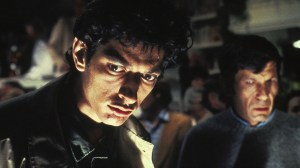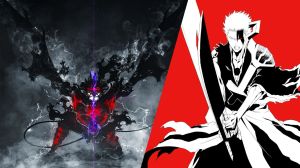
Scott Snyder and Greg Capullo received a well deserved month off with this week’s release of Batman #34, which was scripted by Gerry Duggan with art by Matteo Scalera. But Snyder and Capullo will return next month for Batman #35 as the storyline jumps into the future (taking place after the end of the weekly Batman Eternal series) and the book’s next big event “Endgame” kicks off.
Videos by ComicBook.com
The creators are already promising that “Endgame” will be a huge storyline, thought it will be difficult to top the size and scope of the recently concluded “Zero Year” arc – which in contrast to “Endgame” was an origin retelling that took place in Batman’s early years.
Either way, fans and critics appear to be in agreement that the Bat-books are currently in the midst of a great renaissance, as creators are churning out quality story after quality story regardless of what point in continuity they occur. “Zero Year” was especially praised for its unique spin on Batman’s origins, while also honoring the character’s history and spirit.
So with an eye towards the future, here are 10 takeaways from Zero Year that have many of us excited for what’s coming next in the Batman universe.

10. Bruce Wayne’s Tortured Past
Across all media, every Batman origin story deals with how Bruce Wayne copes with the murder of his parents, so it was interesting to see how “Zero Year” dealt with one of the most famous traumas in comic book history. One recurring device the creators use to great effect in the story is Bruce being haunted by the image of his mother Martha’s fatal bullet-wound on her forehead when he projects the visual onto other people. Capullo’s artwork for these scenes is horrifyingly disturbing, without it coming across as gross or graphic.
In “Zero Year’s” final chapter in Batman #33, Snyder and Capullo introduce a totally new wrinkle to Brue’s ongoing fight to find closure over the death of his parents when he admits to his trusted friend and advisor Alfred that he underwent shock therapy as a means “to be rebooted. Started over.” Bruce opts out of the extreme treatment just before they’re ready to begin, but it doesn’t change just how emotionally crippled he is by the tragedy of his parents, and how going down that dark path ultimately helped make him Batman.

9. Separating Bruce Wayne from Batman
Demonstrating that Snyder and Capullo thought of almost everything when it came to creating “Zero Year,” there’s a wonderful moment in Batman #24 where the creators are able to come up with a plausible way that will forever separate Batman and Bruce Wayne in the eye’s of the public.
The moment comes on the night that Bruce debuts as Batman. Bruce initially heads into a chemical factory that is overrun with the Red Hood gang as his civilian identity. After being held at gunpoint, he has Alfred cut the power to the factory, so when the Red Hood members put no their night vision goggles, they see Batman jumping in to grab a man that looks like Bruce.
Alfred later explains that the illusion was created by looping and overlaying the feed of Wayne-tech night vision goggle’s to the Red Hood goggles. As such, “Batman’s legend begins with the rescue of Bruce Wayne. Their separation is cemented into the foundation of the mythos.”
If only every superhero that has a secret identity could be so clever and forward thinking.

8. The Batman/Alfred Dynamic
It’s really difficult to find new ground to explore when it comes to a relationship that’s as rich and fulfilling as the one between Bruce Wayne and his servant/friend/surrogate father figure Alfred Pennyworth. As a result, the “Zero Year” creative team decides to play it safe and stick with the classics, highlighting the very best of the Batman/Alfred dynamic and showing why it’s been a fan favorite for so long.
“Zero Year’s” Alfred is strongly opposed to the idea of “Master” Bruce becoming a masked vigilante, at one point even telling Bruce that his recklessness was dishonoring the memory of his parents. But there’s also a pragmatism to this Alfred, and between that and the very sincere paternal love he feels for Bruce, he still stands up for his friend and helps him out every step of the way. In one very poignant scene in Batman #23, he tells Bruce that even when they disagree, he promises to always be there “to patch you up.” When Alfred tries to convince Bruce to get drinks with an old girlfriend at the end of “Zero Year,” the look of resignation and despairing defeat that comes across his face as he tells her that, “he’s spoken for” (as Batman) is both sweet and melancholic.
Ultimately, there are almost as many great Alfred moments in “Zero Year” as there are great Batman moments.

7. Jim Gordon and the Coat
For half a minute, it looked like Snyder and Capullo were going to dramatically alter the characterization of one of the most beloved supporting characters in comic book history in policeman James Gordon. Instead, the creative team came up with one heckuva twist involving Gordon’s earliest days as a beat cop in Gotham, which ultimately help make the character even more of a standout.
Initially, Gordon is presented as a shady, possible compromised cop, who busted Bruce when he was just a child for truancy. While Bruce was in the back of the police car, he sees Gordon take a gift from somebody – a coat. Bruce asks why so many people are giving the cops gifts when Gordon tells him it’s because they make everybody “feel safe.” Except Bruce figures out that these are bribes, which causes him to write off Gordon as just another crooked cop.
Except that’s not the whole story. While he’s in his Batman identity, Gordon tells him about the time he tried to bust his superior for running a dog-fighting ring. When the other cops turn the dogs on Gordon, nearly killing him, he decides to hang on to the gifted coat as a reminder to his crooked partners and to himself. This plot twist would resurface again after Batman and Gordon worked together to save Gotham from the Riddler. Bruce presents Gordon with a new coat, one that he earned for doing what he said he did to Bruce years earlier – for making people feel safe.

6. Connecting Batman to the Red Hood
As Batman’s greatest villain (and one of the greatest bad guys in all of comics), the Joker inevitably finds his way into almost every great “Dark Knight” story. In “Zero Year,” Snyder and Capullo find a way to link the Joker (as he previous alter ego, the Red Hood) to the Caped Crusader in his very first night on the job as Batman. And the creators do it in a way that’s both subtle and fun.
The Red Hood first appeared in 1951’s Detective Comics #168 when the character was attempting to rob a chemical plant and is confronted by Batman. The Red Hood jumps into a vat of chemicals, transforming him into the green-haired, white-skinned Joker.
In “Zero Year” Bruce Wayne convinces himself to defend Gotham as Batman after he returns home and finds that the city has been taken over by a violent gang known as the Red Hoods. During his first outing as Batman, he takes on the gang at a chemical factory. While fighting the group’s leader, Red Hood One, the character refuses Batman’s help and instead drops into a vat of chemicals (wearing a huge smile).
It’s just a simple little nod to the Joker’s history, and the character is not referenced again after that. At the same time, the moment marks some great work from Snyder and Capullo to connect Batman with his arch-nemesis at such an early juncture continuity-wise.

5. The Dark Knight Doesn’t Need to Always Be Dark
While it’s inaccurate to generalize that all Batman comics are “dark” in terms of coloring and aesthetic, probably the most famous reimagining of the character’s origins, Frank Miller and David Mazzucchelli’s “Batman: Year One,” is notorious for its subdued color palette, and use of shadows. As such, any future attempts to update Batman’s origins, such as “Zero Year,” are going to drawn comparisons to “Year One.”
One of the starkest creative differences one finds in “Zero Year” when compared to “Year One,” is how the creative team colors Gotham City and the rest of Batman’s world. There are plenty of scenes of darkness and shadows, but there are also a number of beautiful pages using bright and vibrant colors, including shades of red, orange, green and yellow. A double-page spread in Batman #24 pays homage to the Caped Crusader’s first appearance In Detective Comics #27, but puts the visual in front of an almost garish orange/sunburst backdrop.
There’s no question that “Year One” is an amazing story – arguably the greatest Batman tale ever. But it’s refreshing all the same to see “Zero Year’s” creative team add some fun splashes of color to Batman’s early years. At the end of the day, comic books are supposed to be fun, so why shouldn’t there be a touch of hot pink in a Batman comic to remind us of that?

4. The Riddler Can Be a Great Featured Villain
“Zero Year” is filled with moments of nuance and subtlety, but there’s no question that Snyder and Capullo did some real creative heavy lifting when it came to transforming Edward Nygma, aka, the Riddler, into a formidable threat with a logical link to Batman’s origins.
Nygma is first connected to Batman’s world when it’s revealed that he’s the special assistant to Bruce’s Uncle Philip. The storyline establishes from the onset that Nygma’s brilliance is without peer, making the character all the more terrifying when he turns on Philip and hires Doctor Death (one of Batman’s earliest villains from the Golden Age) to steal technology that will eventually give him the ability to take control of Gotham.
Throughout “Zero Year” Ridder is constantly one step ahead of Batman, and the consequences of the Caped Crusaders failures are very real and harsh. Gotham is reduced into a dystopian city after the Ridder floods it and takes control, appearing on a giant screen once a day to challenge survivors to a game of wits (with the loser falling into a bit filled with jackals). The ease at which Nygma pulls every string causes Bruce to seriously doubt himself. As a result, Batman’s ultimate victory over the Riddler is quite satisfying, because it feels earned and like a true character-defining moment for one of the world’s greatest heroes.

3. The Reason for Batman
A number of creators have explored the question “why” Batman does what he does, but very few have fully justified why a wealthy man who runs his own company and doesn’t have any true superpowers to speak of, puts on a cape and a cowl and sets out playing the role of protector of Gotham City every day and night. That’s because the “why” with Batman is a pretty complex question.
But Snyder finds a way to simplify this age-old conundrum in a way that’s both insightful but inherently true to the character and his 75 years of history. On one of the final pages of “Zero Year’s” final chapter (Batman #33), Alfred asks Bruce about grabbing a drink with an old female friend, and Bruce maintains that the social act would be pointless since he’s never going to be able to settle down with someone and quit being Batman. Alfred tries to convince Bruce to reconsider, but Bruce responds by talking about the emotional trauma he experienced after his parents’ deaths and how he’s been constantly seeking to find something – “the crazy thing that would keep me from going crazy.” As Batman, Bruce realizes that he can be a lighting rod for Gotham’s villainy and show the people not to be afraid. And that’s a role that gives him fulfillment and makes him “happy.”
Bruce is Batman, because it makes him happy to be Batman. It’s “all” that makes him happy.
It’s only fitting that Snyder was able to pen such a joyful story involving Batman’s origins. That’s because his Batman is joyful about being Batman.

2. Early Batman Can Be Big
A number of stories that are set in Batman’s earlier years (such as “Year One” or The Long Halloween) seem to be grounded in a certain level of realism. As a result, these stories tend to focus more on Batman getting his feet wet as a crime fighter, which in turn builds his strength, wits and endurance so he could hypothetically tackle some of the bigger, more fantastical conflicts he faced in his later years.
But “Zero Year’s” third chapter seems to toss some of those ideas aside and instead puts together a grand, operatic Batman story, despite the fact that it is supposed to be an origin story. The final chapter involving the Riddler plays especially big, as Batman is immediately thrust into do or die predicaments with millions of lives at stake if he fails. This go big or go home approach raises the stakes of the story tremendously, and also helps connect readers to supporting characters like Gordon, Alfred and Lucius Fox, because it’s abundantly clear that Batman needs plenty of help to neutralize a threat as dangerous as the Riddler.

1. Scott Snyder Has Established Himself as An All-Time Great Batman Writer
It’s been nearly three years since Snyder started writing Batman full-time, and he’s had a number of critically and commercially successful stories under his belt. But with the completion of “Zero Year,” Snyder should almost certainly be in the conversation for one of the greatest Batman writers of all-time – especially in the modern era.
“Zero Year” is an insightful look at Batman’s earliest days that’s both respectful of all of the great creators that have worked on this character that came before Snyder, while also having the courage to tackle some grand ideas about the “Caped Crusader.” Snyder has a tremendous grasp on Batman history, even going as far back as the Golden Age, as he works in a number of references from classic stories, and even slips in a tongue-in-cheek callout to a not-so-beloved story when a “god *bleeped* Batman” gets censored out of a panel.
But beyond continuity-checking, it’s absolutely refreshing to read a mainstream comic book about a character that’s as wildly popular as Batman (and is thereby going to sell copies no matter what), with a creator at the helm that maintains the momentum for a project that’s as broad as “Zero Year.” “Zero Year” is relentless in the best way possible and ends on a total satisfying and poignant note that feels quite fitting for an arc that has just been doled out over the span of a year’s worth of comics. Few creators, working on any character, have that level of talent, but Snyder seems capable of almost anything, which makes the prospects of his next storyline, “Endgame” all the more exciting.








